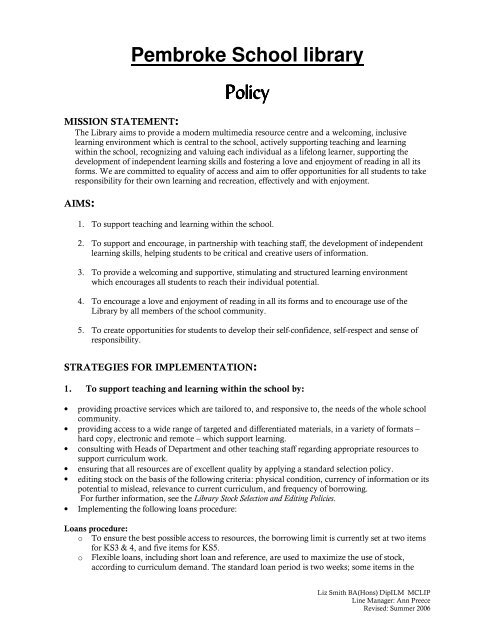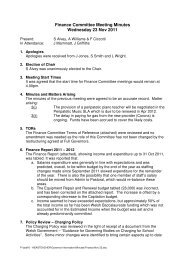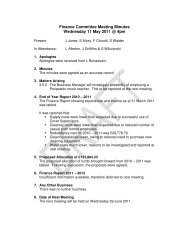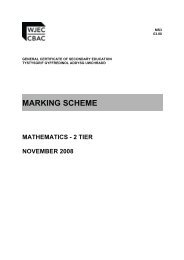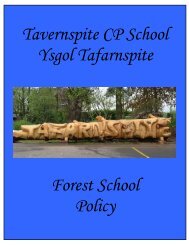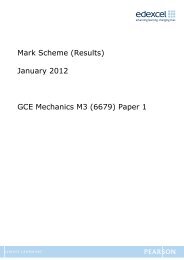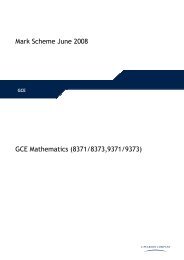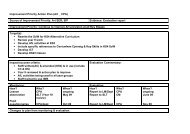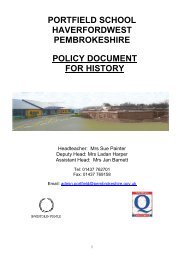You also want an ePaper? Increase the reach of your titles
YUMPU automatically turns print PDFs into web optimized ePapers that Google loves.
The Librarian is full time and employed for 52 weeks of the year.The role of the Librarian is to:• work closely and proactively with teaching staff to provide professional services and facilities insupport of learning across the whole school.• lead the development and promotion of the Library.• be responsible for the strategic and day-to-day management of the Library.• manage the Library budget effectively in accordance with school procedures and principles ofbest value.• support the curriculum across the school in order to enhance the learning experience of everystudent.• exploit every opportunity to promote the Library, its stock and services.The Librarian is line managed by the Assistant Headteacher with responsibility for learning.The Librarian has Head of Department status in order that the needs of all departments within theschool can be fully appreciated, understood and met. It should be expected as normal practice that theLibrarian is invited to curriculum planning meetings, learning and teaching, and literacy-relatedmeetings where appropriate.The Librarian and the Library Assistant are included in the school’s own INSET, as well as havingregular access to external training opportunities, as appropriate. The Librarian is an active member ofprofessional organisations and network meetings, such as SLA (<strong>School</strong> Library Association), CILIP(Chartered Institute of Library and Information Professionals) and its professional interest group, SLG(<strong>School</strong> Libraries Group).The Librarian is currently a <strong>School</strong> Library Association Executive Committee member, elected to servefor 3 years (2004-2007), Immediate Past Chair of the South West Wales Branch of the <strong>School</strong> LibraryAssociation and Secretary of the <strong>School</strong> Libraries Group Wales.The Librarian and the Library Assistant are included in the whole-school performance review meetings.The Librarian supervises the Library Assistant in his/her duties, supporting him/her fully in his/herrole and carrying out his/her performance review.SELECTION AND MAINTENANCE OF RESOURCES:The Library plays a central role in the life of the school and adopts a proactive approach to providingservices, striving to respond to current needs and anticipate and address future needs of the wholeschool community.Departmental liaison:The Librarian is familiar with the courses offered by all departments, liaising with teaching staff toidentify resources to support these courses. Staff from each department are responsible forrecommending and requesting items for purchase. Each department has a nominated <strong>library</strong>representative who works closely with the Librarian to ensure that mutual knowledge and expertise isfully exploited for the benefit of all students.Each Head of Department and departmental Library representative receives an ‘Annual TopicInformation sheet’ during the Summer Term, enabling updates of curriculum and exam board changesetc, as well as requests for specific resources to be communicated formally.All resources are selected in accordance with the Library’s selection criteria to ensure high quality,appeal, currency and appropriateness, as well as to ensure that cultural diversity is represented and biasLiz Smith BA(Hons) DipILM MCLIPLine Manager: Ann PreeceRevised: Summer 2006
and stereotyping are avoided. (For further information, see the Library Stock Selection and EditingPolicies).Resources should form part of a balanced collection, providing differing perspectives and information,helping students towards an understanding of cultures and ways of living different from their own.Library resources include a range of alternative formats to support each topic studied and to supportstudents’ individual learning styles:• General and subject-specific books for loan and reference• General and subject-specific magazines and journals covering a broad range of topics• Newspapers in hard copy• Audiovisual and multimedia materials, including DVDs, videos, CDs, audiocassettes, and CD-ROMs, which complement more traditional formats.• A ‘Quick Reference’ collection, including a range of dictionaries, encyclopaedias anddirectories• Posters, leaflets and information packs• Educational gamesFunding:Sufficient funding needs to be available to allow for the replacement of out-of-date or worn stock andfor the selection of new stock to reflect changes in the curriculum and meet users’ needs at all levels ofability.• CILIP recommends replacement of 10% of stock every year to ensure adequate provision 2 .• The Book Trust document Recommended Spending in <strong>School</strong>s 3 states that a minimum spend on<strong>library</strong> stock per pupil should be £17.50 per secondary school pupil.• The SLA recommends a stock of 13 -18 items per pupil aged 11-16 and 17-25 items per pupil inthe 16-18 age range 4 . At current pupil numbers for <strong>Pembroke</strong> <strong>School</strong>, this would mean 17,680 –24,480 items for the former and 3,400 – 5,000 items for the latter, a total of 21,080 items.Facilities:Library facilities include:• A computerised catalogue of all the Library’s, enabling users to search for items on thedesignated networked machines within school, to check whether an item is available, to maketheir own lists of resources for further reading, and to view the range of resources available tosupport a particular project or topic.• A minimum of 12 networked computers, each with Internet access and CD-ROM drives. Thisnumber should not exceed 15; the Library should be used as a resource base for informationliteracy lessons, involving a range of sources, rather than an alternative computer room.• DVD / Video viewing equipment• CD / Cassette listening equipment• A colour printer and scanner• A heavy-duty black and white laser printer• Photocopying facilitiesMONITORING AND EVALUATION:It is essential that the Library constantly examines critically and reviews the quality of its provision andidentifies areas for improvement. Only then can it be in a position to respond to current needs,anticipate and address future needs and ensure the highest levels of satisfaction among the whole schoolcommunity.2 BARRETT, Lynn & DOUGLAS, Jonathan. (2004) Guidelines for Secondary <strong>School</strong> Libraries. Facet Publishing3 LIBRARY AND INFORMATION COMMISSION. (2002) Recommended Spending in <strong>School</strong>s. Research Report 120, Spring 2002. [Online].[Accessed 29.8.06]. Available from the World Wide Web: 4 SCHOOL LIBRARY ASSOCIATION. (2006) Book Stock Guidance [Online]. [Accessed 29.8.06]. Available from the World Wide Web:Liz Smith BA(Hons) DipILM MCLIPLine Manager: Ann PreeceRevised: Summer 2006
In conjunction with the whole-school development review process, the Library produces an annualdevelopment plan and five-year strategic plan, enabling the identification of priorities and key areas fordevelopment.The Library is using the DfES Self-Evaluation tool, Improve Your Library: A Self-Evaluation Process forSecondary <strong>School</strong> Libraries and Learning Resource Centres, 5 to support its self-review process, targeting keyareas over a number of years.5 DfES. (2004) Improve Your Library: A Self-Evaluation Process for Secondary <strong>School</strong> Libraries and Learning Resource Centres. [Online].[Accessed 22.8.06]. Available from World Wide Web: Liz Smith BA(Hons) DipILM MCLIPLine Manager: Ann PreeceRevised: Summer 2006


